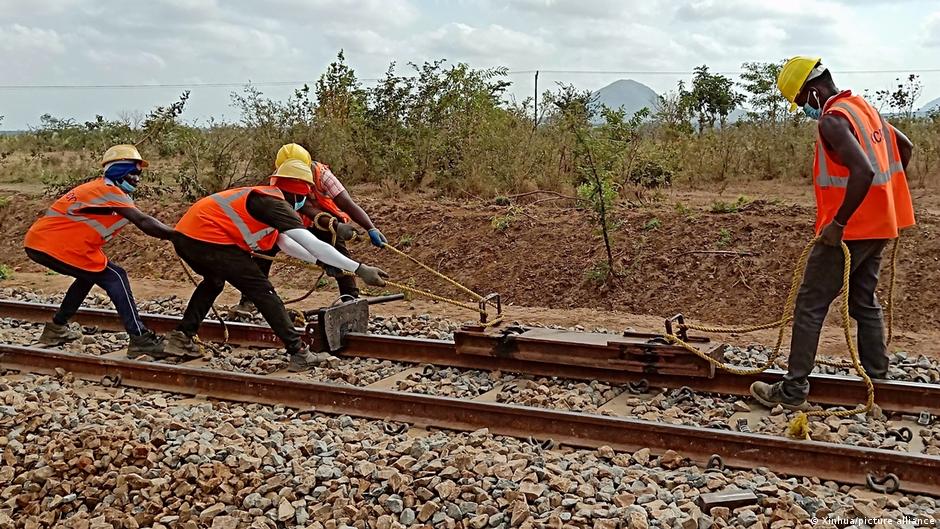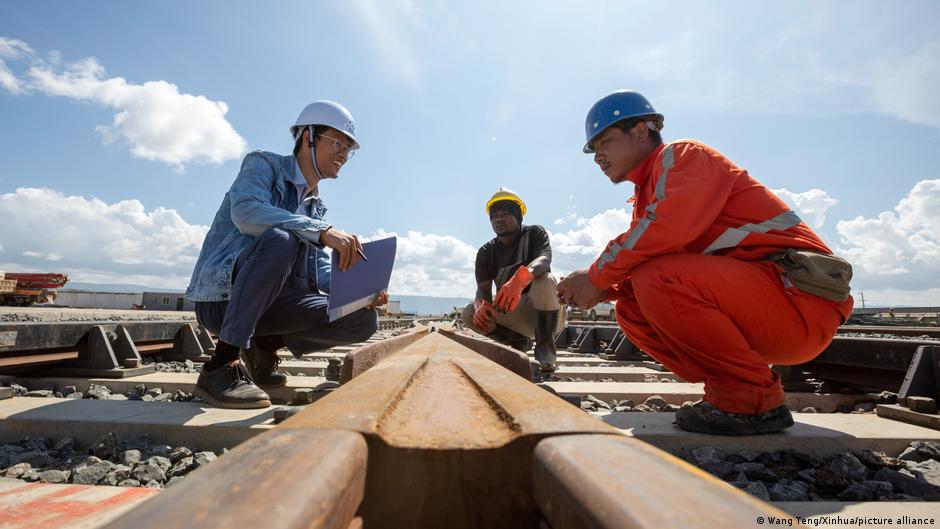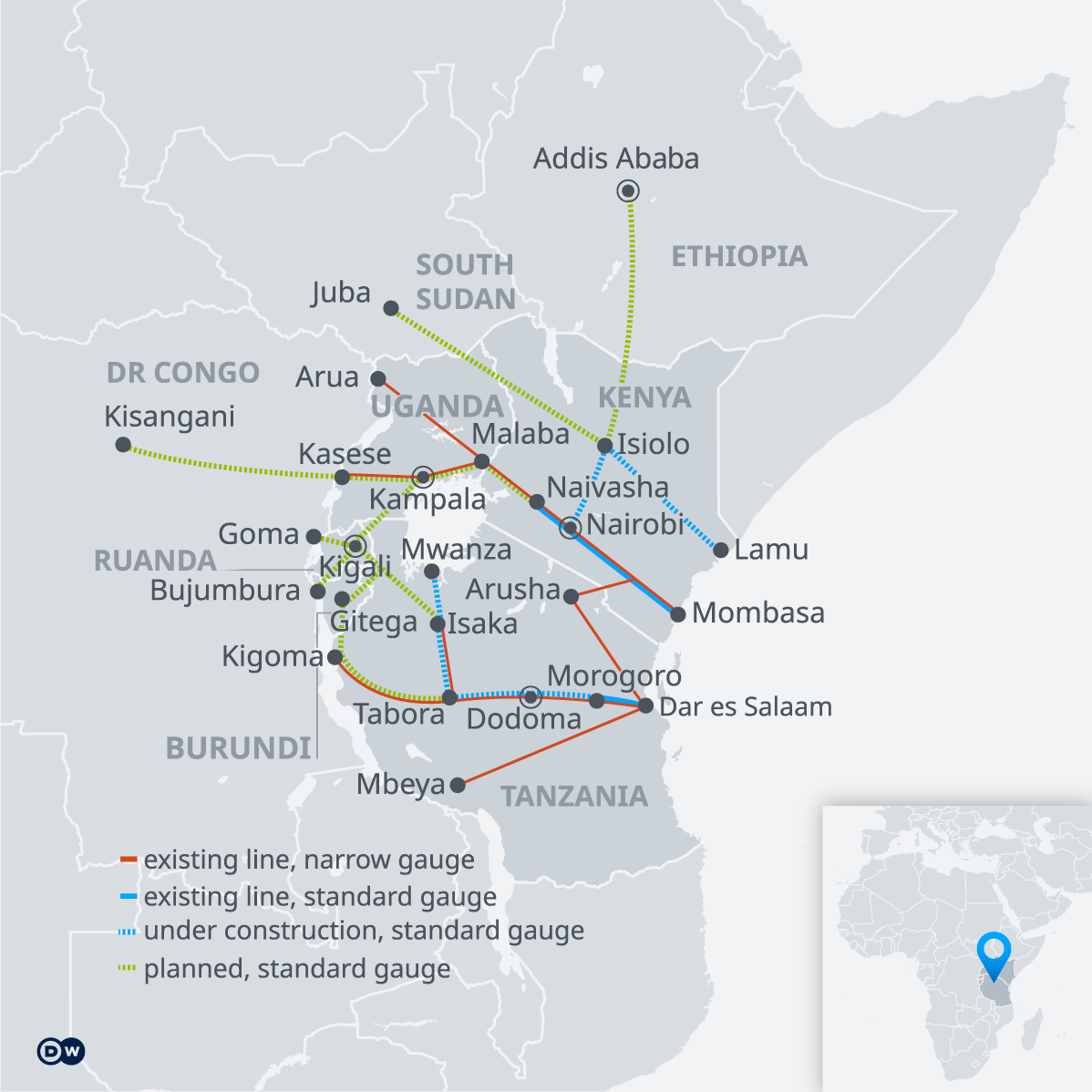Turkey supplants China in East Africa

The project has stalled for years, but now Uganda wants to breathe new life into a standard gauge railway (SGR) linking its capital, Kampala, to Malaba in neighbouring Kenya, eventually reaching the Indian Ocean. The railway line is part of a more extensive planned network of SGR lines designed to connect East African coastal and land-locked countries as part of a pan-African infrastructure project. "The standard gauge railway is to offer bulk transportation – reliable, faster, with a turnaround time of one day travel from Mombasa," said David Mugabe, in charge of communications for the project.
The country on the African Great Lakes formally terminated a $2.2 billion (€2 billion) contract with its Chinese partner. In 2015, the China Harbour Engineering Company was awarded the contract to build the stretch from Kampala to the Kenyan border town of Malaba. Negotiations went back and forth for years. Finally, the pandemic came along, limiting the economic scope of both countries. Ultimately, the China Exim Bank refused to provide the funding.
"Chinese countries have been given lots of contracts in the country: hydro-power projects, road construction projects," said John Kibego, a Ugandan journalist. "If in this case they failed to implement in the time agreed or maybe the conditions set are not favouring the government, it is okay if the government wants to change things," Kibego said, stressing that "the government serves the citizens. When the government mis-negotiates, the burden falls on the citizens."
The Chinese de facto monopoly on infrastructure projects in the country may be dwindling. "The government is in discussions with new, Turkish partners," project spokesperson David Mugabe said. "An [memorandum of understanding] has been signed, with the aim of moving towards a final contract. And this involves both technical and financial preparations."

Turkey’s African boom
Turkey has been expanding its presence on the African continent, according to Yunus Turhan, an expert on Turkish-African relations at Haci Bayram Veli University in Ankara. More than 1,500 [Turkish] companies have invested at least € 64.7 billion in the continent, said Turhan. According to his data, the trade volume has more than doubled in the last two decades and was 27 billion dollars in 2020.
The increased cooperation with Turkish partners, who have been able to score points over Chinese companies in terms of price, speed and quality, should also be viewed in this context, he said. But it's not private businesses only that have tried to tap into Africa's potential. "There is a complementary process going on where Turkey has greatly attached itself to Africa in the last twenty years," explained Turhan.
"Turkey has opened embassies in more than 40 African countries, Turkish Airlines is now flying to 60 African destinations, and Turkish scholarship programmes invite Africans to study in Turkey," he continued, adding that Turkey is now booming in Africa in terms of hard power and soft power combined.
One leading Turkish firm to have set foot in Africa is Yapi Merkezi. Arguably the single biggest foreign investment by a Turkish company happens to be a standard gauge railway constructed by Yapi Merkezi in Tanzania. In Uganda, the company built a major road that, as journalist John Kibego points out, has received much acclaim from citizens and politicians alike. That's why Yapi Merkezi has been earmarked to take over the first phase of Uganda's standard gauge railway, as regional media have reported.

"The Turkish companies have done a good job in terms of quality, there is no doubt that they will finish the job on time and deliver the best quality," Kibego said. The company is also known for following a different approach to financing, with European export credit agencies playing a major part – an approach that will come in handy for Kampala after China's reluctance to fund the project.
Two lines promoting regional integration
The different stages of the so-called northern and central corridors of the East African SGR endeavour may have a lot to do with the role China has been playing in the respective projects. The central corridor has made significant progress since the first in four of the project's six phases was awarded to Yapi Merkezi in 2017. The Dar es salaam-Morogoro line is set to open in the coming months since the first tests proved successful last year. The second section connecting Morogoro to the capital Dodoma, in central Tanzania, and beyond, is in its final phase.
Last December, Tanzania's President Samia Suluhu Hassan oversaw the signing of the sixth phase of the project, the last to be commenced and one of only two involving Chinese firms. Construction is set to be complete in 2026, though further projects are planned to take the railway into Rwanda and Burundi and on to the Democratic Republic of the Congo.
Addressing doubts that the 10-billion-dollar debt was worthwhile, President Suluhu stressed the project would only fully pay out in the long term. "Today's pain for Tanzanians will be tomorrow's gain," Suluhu said. "Upon completion of the SGR, Tanzania will be in a better position to utilise its strategic geographical positioning to facilitate cross-border trade," the president was quoted as saying.

Expanding the rail network has become something of a regional competition. The Tanzanian line forms the "central corridor" to the interior of the continent. "All countries in East Africa are investing in the SGR routes to boost their economies," says Ugandan economist Isaac Khisa. "Kenya, Tanzania, Rwanda and the Democratic Republic of Congo are investing in SGR. In this context, Uganda, which lies between all these countries, sees itself as a hub for regional trade."
But the country is now lagging behind with the implementation of its standard gauge railway. The "northern corridor" in the regional rail network, which starts in the Kenyan port city of Mombasa, should one day connect Kisangani in Congo, Kigali in Rwanda and Juba in South Sudan. To date, it ends in Naivasha, about 90 kilometres west of the capital Nairobi.
Quick fix: reviving colonial connections?
So for now, Dodoma is ahead. "In Kenya, increased cost on mega projects has been attributed to political cartels capturing strategic project lanes so as to cash in," admitted James Shikwati, founder of the Inter Region Economic Network (IREN Kenya). "This might not necessarily be the case in Tanzania."
The standard gauge railway from Mombasa to Nairobi was Kenya’s most expensive infrastructure project to date. While the Tanzanian counterpart is largely run autonomously by the Tanzanian Railway Company, the Kenyan prestige project remains in the hands of Chinese operators. Rail revenues are to be used to pay off Kenyan debts. Moreover, the use of the port had been tied to the transport of goods by rail – a concession to China that William Ruto reversed immediately after taking office in September 2022.
Kenya and Uganda would nevertheless appear to be pursuing a two-pronged approach: the narrow-gauge railways from colonial times are gradually being repaired at a lower rate of investment in order to achieve a seamless connection to Congo and South Sudan as quickly as possible. These remain less resilient than the standard gauge system, however. In the long run, investing in the new gauge would pay off, says economic expert Shikwati in Nairobi.
"Debt is not necessarily a bad thing," he writes. "Businesses also take on debt." What is more important, he says, is that this debt serves the "right" purpose, namely to spur development.
Philipp Sandner, Emmanuel Lubega & Burak Unveren
© Deutsche Welle 2023
